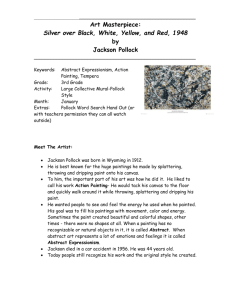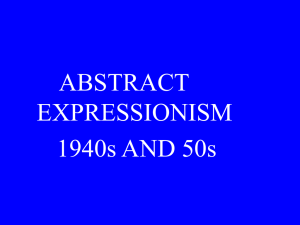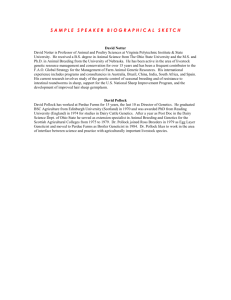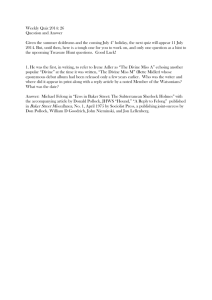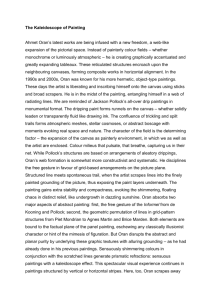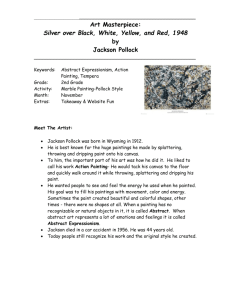Pollock Paints a Picture
advertisement
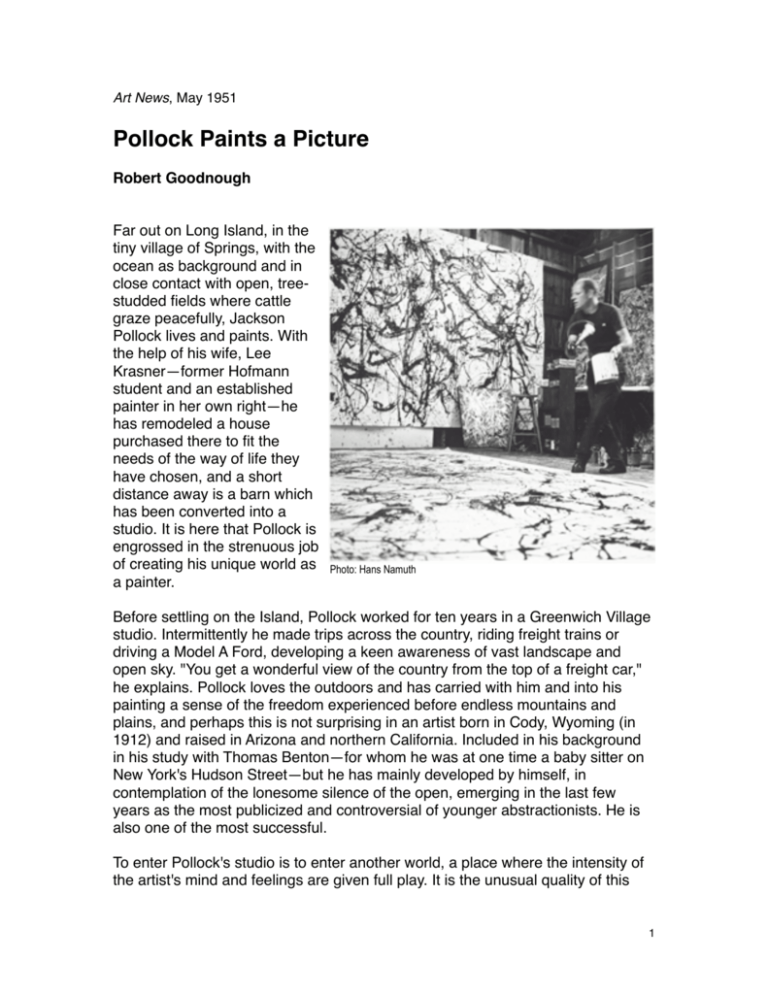
Art News, May 1951 Pollock Paints a Picture Robert Goodnough Far out on Long Island, in the tiny village of Springs, with the ocean as background and in close contact with open, treestudded fields where cattle graze peacefully, Jackson Pollock lives and paints. With the help of his wife, Lee Krasner—former Hofmann student and an established painter in her own right—he has remodeled a house purchased there to fit the needs of the way of life they have chosen, and a short distance away is a barn which has been converted into a studio. It is here that Pollock is engrossed in the strenuous job of creating his unique world as a painter. Photo: Hans Namuth Before settling on the Island, Pollock worked for ten years in a Greenwich Village studio. Intermittently he made trips across the country, riding freight trains or driving a Model A Ford, developing a keen awareness of vast landscape and open sky. "You get a wonderful view of the country from the top of a freight car," he explains. Pollock loves the outdoors and has carried with him and into his painting a sense of the freedom experienced before endless mountains and plains, and perhaps this is not surprising in an artist born in Cody, Wyoming (in 1912) and raised in Arizona and northern California. Included in his background in his study with Thomas Benton—for whom he was at one time a baby sitter on New York's Hudson Street—but he has mainly developed by himself, in contemplation of the lonesome silence of the open, emerging in the last few years as the most publicized and controversial of younger abstractionists. He is also one of the most successful. To enter Pollock's studio is to enter another world, a place where the intensity of the artist's mind and feelings are given full play. It is the unusual quality of this 1 mind, penetrating nature to the core yet never striving to show its surface, that has been projected into paintings which captivate many and agitate others by their strange, often violent, ways of expression. At one end of the barn the floor is literally covered with large cans of enamel, aluminum and tube colors—the boards that do show are covered with paint drippings. Nearby a skull rests on a chest of drawers. Three or four cans contain stubby paint brushes of various sizes. About the rest of the studio, on the floor and walls, are paintings in various stages of completion, many of enormous proportions. Here Pollock often sits for hours in deep contemplation of work in progress, his face forming rigid lines and often settling in a heavy frown. A Pollock painting is not born easily, but comes into being after weeks, often months of work and thought. At times he paints with feverish activity, or again with slow deliberation. After some years of preparation and experimentation, during which time he painted his pictures on an easel, Pollock has developed a method that is unique and that, because of its newness, shocks many. He has found that what he has to say is best accomplished by laying the canvas on the floor, walking around it and applying the paint from all sides. The paint—usually enamel, which he finds more pliable—is applied by dipping a small house brush or stick or trowel into the can and then, by rapid movements of the wrist, arm and body, quickly allowing it to fall in weaving rhythms over the surface. The brush seldom touches the canvas, but is a means to let color drip or run in stringy forms that allow for the complexity of design necessary to the artist. In his recent show, at the Parsons Gallery, Pollock exhibited a very large work, titled Number 4, 1950. (Pollock used to give his pictures conventionally symbolic titles, but—like many contemporary abstractionists—he considers them misleading, and now simply numbers and dates each work as it is completed.) It was begun on a sunny day last June. The canvas, 9 by 17 feet, was laid out flat, occupying most of the floor of the studio and Pollock stood gazing at it for some time, puffing at a cigarette. After a while he took a can of black enamel (he usually starts with the color which is at hand at the time) and a stubby brush which he dipped into the paint and then began to move his arm rhythmically about, letting the paint fall in a variety of movements on the surface. At times he would crouch, holding the brush close to the canvas, and again he would stand and move around it or step on it to reach to the middle. Within a half hour the entire surface had taken on an activity of weaving rhythms. Pools of black, tiny streams and elongated forms seemed to become transformed and began to take on the appearance of an image. As he continued, still with black, going back over former areas, rhythms were intensified with counteracting movements. After some time he decided to stop to consider what had been done. This might be called the first step of the painting, though Pollock stresses that he does not work in stages. He did not know yet when he would feel strongly enough about the picture to work on it again, with the intensity needed, nor when he would finally be finished with it. The paint was allowed to dry, and the next day it was nailed to a wall of the studio for a period of study and concentration. 2 It was about two weeks before Pollock felt close enough to the work to go ahead again. This was a time of "getting acquainted" with the painting, of thinking about it and getting used to it so that he might tell what needed to be done to increase its strength. The feverish intensity of the actual painting process could not be kept up indefinitely, but long periods of contemplation and thought must aid in the preparation for renewed work. In the meantime other paintings were started. When he felt able to return to the large canvas with renewed energy, Pollock placed it back on the floor, selected a light reddish brown color and began again to work in rhythms and drops that fell on uncovered areas of canvas and over the black. Occasionally aluminum paint was added, tending to hold the other colors on the same plane as the canvas. (Pollock uses metallic paint much in the same sense that earlier painters applied gold leaf, to add a feeling of mystery and adornment to the work and to keep it from being thought of as occupying the accepted world of things. He finds that aluminum often accomplishes this more successfully than greys, which he first used.) Again the painting was allowed to dry and then hung on the wall for a few days' renewed consideration. The final work on the painting was slow and deliberate. The design had become exceedingly complex and had to be brought to a state of complete organization. When finished and free from himself the painting would record a released experience. A few movements in white paint constituted the final act and the picture was hung on the wall; then the artist decided there was nothing more he could do with it. Pollock felt that the work had become "concrete"—he says that he works "from the abstract to the concrete," rather than vice versa: the painting does not depend on reference to any object or tactile surface, but exists "on its own." Pollock feels that criticism of a work such as this should be directed at least in terms of what he is doing, rather than by standards of what painting ought to be. He is aware that a new way of expression in art is often difficult to see, but he resents presentation of his work merely on the level of technical interest. Such a summation of Pollock's way of working is, of course, only part of the story. It has developed after years of concentrated effort, during long periods when nothing was satisfactory to him. He explains that he spent four years painting "black pictures," pictures which were unsuccessful. Then his work began to be more sure. There was a period of painting symbols, usually of figures or monsters, violently expressed. Of them, She Wolf, now owned by the Museum of Modern Art, was a crucial work. Here areas of brush-work and paint-pouring were combined, the painting being done partly on the floor and partly on the easel. The change to his way of working today was gradual, accompanying his various needs for expression, and though there is a sense of the brutal in what he does this gradually seems to be giving way to greater calm. 3 During the cataclysmic upheavals painting has undergone in recent years there have been rather drastic measures taken with the object. It has been distorted and finally eliminated as a reference point by many artists. The questions arise as to what the artist is dealing with, where he gets his ideas, what his subject matter is, etc. The answer may be found partly in the consideration that these artists are not concerned with representing a preconceived idea, but rather with being involved in an experience of paint and canvas, directly, without interference from the suggested forms and colors of existing objects. The nature of the experience is important. It is not something that has lost contact with reality, but might be called a synthesis of countless contacts which have become refined in the area of the emotions during the act of painting. Is this merely an act of automatism? Pollock says it is not. He feels that his methods may be automatic at the start, but that they quickly step beyond that, becoming concerned with deeper and more involved emotions which carry the paintings on to completion according to their degree of strength and purity. He does not know beforehand how a particular work of his will end. He is impelled to work by the urge to create and this urge and what it produces are forever unknowable. We see paint on a canvas, but the beauty to which we respond is of an intangible order. We can experience the unknowable, but not understand it intellectually. Pollock depends on the intensity of the moment of starting to paint to determine the release of his emotions and the direction the picture will take. No sketches are used. Decisions about the painting are made during its development and it is considered completed when he no longer feels any affinity with it. The work of art may be called an image which is set between the artist and the spectator. A Pollock reveals his personal way of bringing this image into existence. Starting automatically, almost as a ritual dance might begin, the graceful rhythms of his movements seem to determine to a large extent the way the paint is applied, but underlying this is the complex Pollock mind. At first he is very much alone with a picture, forgetting that there is a world of people and activity outside himself. Gradually he again becomes aware of the outside world and the image he has begun to project is thought of as related to both himself and other people. He is working toward something objective, something which in the end may exist independently of himself, and that may be presented directly to others. His work may be thought of as coming from landscape and even the movement of the stars—with which he seems almost intimate at times—yet it does not depend on representing these, but rather on creating an image as resulting from contemplation of a complex universe at work, as though to make his own world of reality and order. He is involved in the world of art, the area in which man undertakes to express his finest feelings, which, it seems, is best done through love. Pollock, a quiet man who speaks with reserve and to the point, is in love with his work and his whole life evolves about what he is doing. He feels that his most successful paintings carry the same intensity directly to the edges of the canvas. "My paintings do not have a center," he says, "but depend on the same amount of interest throughout." Since it has no reference to objects 4 that exist, or to ideal objects, such as circles and squares, his work must be considered from the point of view of expression through the integration of rhythm, color and design, which he feels beauty is composed of. Physical space is dispensed with as an element in painting—even the dimensions of the canvas do not represent measurements inside which relationships are set up, but rather only determine the ends of the image. Pollock's Number 4, 1950 is concerned with creating an image in these terms. In this it is like much of his other work, but it is also among his most successful paintings, its manifold tensions and rhythms balancing and counteracting each other so that the final state is one of rest. In his less realized paintings one feels a lack of rest: movements have not been resolved. Colors in Number 4, 1950 have been applied so that one is not concerned with them as separate areas: the browns, blacks, silver and white move within one another to achieve an integrated whole in which one is aware of color rather than colors. Nor is the concern with space here. There is no feeling that one might walk bodily into the rectangle and move about. This is irrelevant, the pleasure being of a different nature. It is more of an emotional experience from which the physical has been removed, and to this intangible quality we sometimes apply the word "spiritual." In this picture Pollock has almost completely eliminated everything that might interfere with enjoyment of the work on this level. It is true the painting is seen through the senses, but they are only a means for conveying the image to the aesthetic mind. One is not earthbound in looking at Number 4, 1950. In lesser paintings one does not feel this sense of release from physical reactions. The experience Pollock himself has had with this high kind of feeling is what gives quality to his work. Of course anyone can pour paint on a canvas, as anyone can bang on a piano, but to create one must have purify the emotions; few have the strength, will or even the need, to do this. http://artnews.com/issues/article.asp?art_id=2401 5

